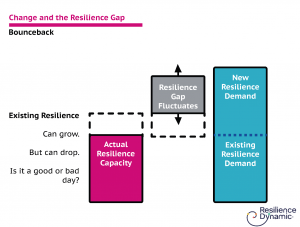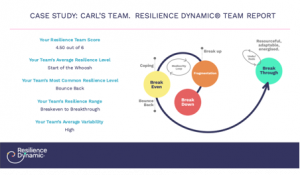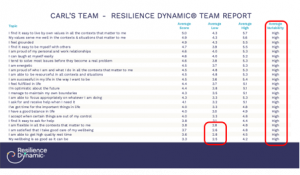In this series, Jenny Campbell explores resilience and wellbeing, and the ethics of coaching for healthy organisations
Part 2: How to banish burnout with resilience team coaching
As part of our endeavours at Resilience Dynamic to enable organisations to foster a healthy, high-performance culture, we’ve carried out research over more than 15 years into what helps build resilience, helping us as team coaches focus on what will really make a difference.
Through our research, we’ve found that those with the highest resilience proactively build in surplus what we call ‘Adaptive capacity’, thereby being able to handle the unexpected well and unlock innovation in healthy ways. How do we as team coaches help this come about? This article offers some pointers, with the illustration of a case study.
Background
We’re now witnessing data after data highlighting the extent of the problem that organisations face: widespread burnout. A total of 50% of the 30,000 employees surveyed across 25 countries by recruitment company Adecco in 2022 suffered near or full burnout. (Adecco, 2022) Yes, you read that correctly: 50%.
As we know, this doesn’t mean just a drop in productivity, but a rise in employee attrition. People vote with their feet, and in the face of risk of actual burnout, attrition rises by two to three times, with double that number plotting to leave within 12 months (McKinsey, 2022).
In the last article, we highlighted the growth in the disconnect between what leaders versus managers and front line workers experience. Leaders are pushing for greater efficiencies and productivity. In the meantime, first line and middle managers, plus the wider workforce are exhausted (Resilience Dynamic, 2022).
At team level, the impact can be felt profoundly. Teams are caught in a continual churn of short-term focus and firefighting. Long hours and a spill across boundaries into home life prevail. Perspective is difficult to grasp and keep. Even senior leadership teams responsible for strategy, are finding themselves in firefighting mode.
So how can we resource our clients – and ourselves, of course – to navigate the challenges today?
On the front foot
As we outlined in the last article, Resilience Dynamic adopts a See – Understand – Optimise framework to help teams get on the front foot. We believe as team coaches that working with resilience, it helps to have specific and clear data. Otherwise, teams – and their coaches – get lost when it comes to knowing what will really make the difference. Team members know they’re tired, but they don’t know what to do to mitigate the burnout risk.
This first step, ‘See’, is pivotal. As our community of practice has learnt through the Resilience Accreditation programme, and undoubtedly there will be other methods than ours, enabling a team to enquire into its situation and data can be phenomenally powerful in coaching.
Resilience Engine coaches learn how to apply our research findings to frame the work, for example, sharing how common burnout is and what can lead to it, and the different levels of resilience that we’ve identified. Coaches can then offer the Resilience Dynamic Questionnaire (via the ‘Dashboard’ service) for leaders, working one-to-one, then aggregating all the scores to see the implications for the whole team. Having the results illustrated via our research model, the Resilience Dynamic®, helps the team to understand current resilience levels, the team’s range and opportunities for boosting resilience.
The process creates a common language that respects individual confidentiality whilst enabling a safe container for sharing vulnerabilities across the team. We witness teams feeling simultaneously relieved, curious and motivated. It’s an energising combination!
Case study: Carl’s senior leadership team
In the first article in this series, you read about ‘Carl’, a senior leader who was chronically driven to be in what we call ‘Bounceback’. While it is a high-performing level of resilience, Bounceback comes with its own health warnings, and in particular, burnout. ‘Bouncebackers’ love to take on challenge, but when there is too much, they slip back into Coping. If this cycle continues, the risk of burnout rises rapidly, especially if there is high instability (see Figure 1).
For Carl’s senior leadership team, the most common resilience level was also Bounceback. Interestingly, the range from Breakeven through to Breakthrough showed high variability, meaning there was a continual
cost of switching up and down. The cost was the team’s wellbeing (see Figure 2).
As Carl put it, somewhat ironically to his team about Bounceback, ‘we seem to love this mode; we create it for ourselves’. Yet team members were frustrated to be caught in firefighting mode all the time, and when identifying with their coach the drivers and barriers to their team’s performance, realised that their current mode of ‘running hot’ was unsustainable.
It was evident from the Resilience Dynamic data that the team was experiencing instability and that fatigue was setting in. Members were trading on their wellbeing to keep on going (see Figure 3).
In working with the coach to identify one or two actions that the team members might take together, the team decided to work on three things:
- Stabilising themselves
- Asking for help
- Fostering pride in the team
For stabilising, this meant both individual and collective team work. The principal team enablers for stabilising were twofold: joint reflection time, and checking in with one another. For individuals the most common way to stabilise was to set boundaries more clearly between work and home life.
Fostering pride was an interesting driver to explore in coaching. There was much to celebrate, and in taking the time through and outside of coaching to notice more regularly their patterns, team members were able to see that while still difficult, the pathway they were on was indeed working.
Asking for help was more tricky, and very much dependent on individuals’ set of assumptions on what they ‘ought’ to know versus what they actually knew. This was a longer term aim, but one the team committed to in the coaching.
One of the biggest impacts in the consultancy and coaching work has been that the team has recognised burnout as a risk. Each member – for themselves, the leadership team and their direct teams – is now much more alert to sensitivity ‘thresholds’ when considering how to improve performance. They’re on the lookout for that capacity for change.
This team – used to high performance through a push-push-push mindset – thought its performance would directly correlate to things like setting boundaries, taking time out, sharing, laughing, celebrating, investing in the sometimes called ‘softer’ elements of leadership like fostering energy, supporting one another, being vulnerable and of course investing in wellbeing. The team could now see the direct linkages to performance targets.
Drawing on data in the intervention was pivotal to Carl and his team owning and bringing about the changes. It was a privilege to enable this team to engage and pick up its own team mantle of healthy high performance.
References
- Adecco Group, Global Workforce of the Future, 2022
- McKinsey Health Foundation 2022:
https://www.mckinsey.com/mhi/our-insights/addressing-employee-burnout-are-you-solving-the-right-problem - Resilience Dynamic, 2022, with data from the Resilience Dynamic Indicator, and the Resilience Dynamic Questionnaire:
https://resiliencedynamic.com/resources/research-papers-and-data-insights/
Further information
- The Resilience Accreditation Programme:
https://resiliencedynamic.com/our-solutions/resilience-coaching/resilience-accreditation-programme/ - The Resilience Dynamic Dashboard®:
https://resiliencedynamic.com/our-solutions/the-resilience-dynamic-dashboard/ - The Resilience Dynamic® model :
https://resiliencedynamic.com/resilience-science/
- Jenny Campbell is delivering a Coaching at Work masterclass on resilience on 16 January 2024
- www.coaching-at-work.com/masterclasses
About the author
- Jenny Campbell is the CEO of The Resilience Dynamic.
- jenny.campbell@resilienceengine.com
- www.resiliencedynamic.com


